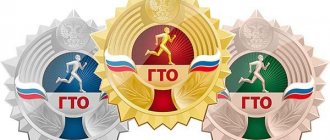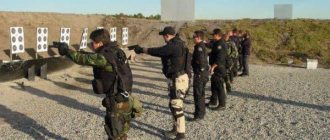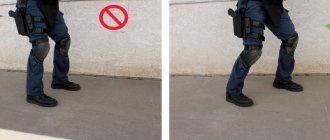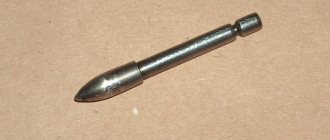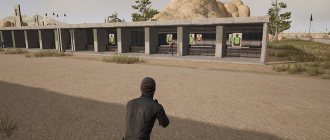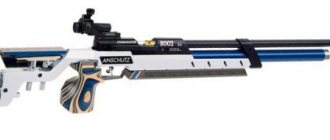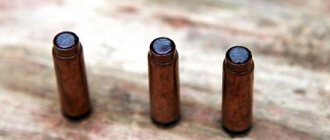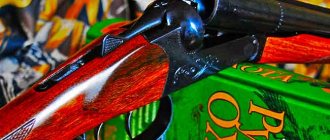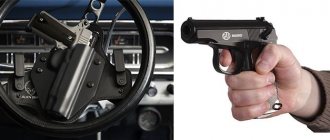Having mastered the necessary skills in handling a bow or crossbow, the next stage in the development of your skills will, of course, be an increase in shooting accuracy, achieved through constant training. Such classes can take place both on the street and in a special room (shooting range), and for maximum efficiency of this process it is very important to use a high-quality shooting target, which must have the following properties:
- be visible and readable from a long distance;
- securely hold the arrow within yourself, preventing it from going beyond its limits;
- do not deform the arrow at the moment of impact;
- withstand multiple hits without destruction;
- do not change its structure as a result of exposure to moisture, as well as during strong temperature changes (heat or cold).
Highest quality targets
Homemade targets very often do not meet these requirements, wear out quickly, and due to this, damage the arrow when hit. In this regard, it is better to purchase bow accessories, in particular targets, from trusted manufacturers.
Our store can offer a wide range of regular ring targets, to which arrow catchers are also added. They are made using indelible paint with bright and easily visible colors. This paint is applied over banner mesh, which can withstand low temperatures and is resistant to various weather conditions.
Archery at targets made on a banner rather than a paper grid will be much more enjoyable and convenient for both a beginner and an experienced shooter, since these products can withstand being hit by an arrow with any type of tip. At the same time, they do not tear or deform. Such a target will last much longer and will be the key to the effectiveness of your training, as well as a gradual increase in shooting skill and accuracy. Target sizes generally range from 30x30mm to 100x100mm.
The arrow catcher is also an important element of the target, which is made of isolon (synthetic material). Its main task is to absorb the kinetic energy of an arrow that hits the target, thereby protecting the shaft and tip from damage. The arrow catcher is equally effective during both frontal and side hits, even at close range.
Classic goals
The standard and familiar target is a target made of paper, with circles drawn on it and markings of points received when hit. These are usually used in shooting ranges. For variety and to remind you what the shots serve, air rifle targets can have designs of wild animals and birds. Standard targets are convenient for novice hunters, but are no less widely used by professional athletes: they are more convenient for scoring. Only in this case are international rules strictly observed, which stipulate both the color of the paper (light cream or white), and its size, and the size of the “apple”, and the diameter of all circles.
How to choose a target
In our store you can buy several types of targets, including lightweight paper ones, as well as 3D targets made from foam materials, which represent three-dimensional figures of various animals (mainly birds).
When choosing and purchasing, you should take into account your skills and intentions in terms of developing your shooting skills. For example, if a target is needed for rare trips to nature and entertainment, then the paper version will be the cheapest and optimal solution. However, if archery or crossbow shooting takes a more significant place in your life and you plan to shoot on a regular basis, then it is better to take a closer look at the targets on the banner grid.
What is “sports shooting”?
This is an Olympic event that tests participants' accuracy.
That is, each athlete shows the level of proficiency with weapons (firearms or pneumatic), as well as his skill. Such shooting has its own standards and assessments, according to which the best participant is determined. Naturally, it requires regular training. The location of the shooting depends on the type of shooting: indoors or in open areas. In addition, during classes you must strictly follow all safety rules so as not to injure yourself or others.
5.1. Competition venue, equipment and venue equipment.
5.1.1. Competitions can take place on a specially equipped rectangular platform for throwing knives. The throwing sector can be located both outdoors and in closed and semi-closed spaces. In cases where the sector is set up outdoors, the stands are installed on the north side so that the sun's rays do not enter the athletes' eyes. The ratio of natural lighting in the hall should be 1:5, 1:6, artificial lighting - at least 600 lux. The sector should be illuminated from above by reflected or diffused light lamps with a protective mesh. When holding competitions indoors, the temperature should be from +15 to +25 degrees Celsius, air humidity should not be lower than 60 percent. Ventilation should provide three air changes per hour.
5.1.2. Each participant must have a throwing lane at least 10 meters long and at least 4 meters wide. The strip should be marked with a border 2.5 cm high, distances (lines) 3.5; 5; 6.5 and 8 m, at the end of the strip a stand with a target is installed (see Appendix Fig. 2, 3.) Behind the stand there should be a knife catcher (mat, tarpaulin curtain, rubber shock absorber). The floor in front of the stand for at least 2.5 m must be lined with a shock absorber that reduces the rebound of the knife. There should be a portable bedside table on the throwing lane - a table for knives. The floor of the sector must be level (without slope). The ceiling height is at least three meters.
5.1.3. All competition participants must perform on the same platform and throw knives in the same direction. If men and women compete in parallel in competitions, then the part of the site on which women perform is separated from the part of the site on which men perform by a longitudinal corridor at least 4 meters wide, the women's sector is located on the left.
5.1.4. Above each stand, opposite its center, a letter index A, B, C, D, etc. is fixed, the same index is installed at each throwing line, with the front side facing the audience.
5.1.5. Beyond the farthest distance there is a neutral zone 3 meters wide, and beyond that there is a waiting zone of up to 3 meters.
5.1.6. Only judges and participants performing the exercise may be in the neutral zone.
5.1.7. All markings of the site are made with clearly visible lines (chalk, white tape, bright tape, contrasting paint) and should not interfere with judges and athletes when approaching the stands.
5.1.8. The height of the throwing stand must be at least 2 meters, the width must be at least 1 m. The working surface of the stand is formed by cubes of wood, stacked on top of each other, with annual rings towards the throwing line (Fig. 3).
5.1.9. The target is mounted at a height of 1.5 meters from the floor to the middle of the central scoring area of the target.
5.1.10. Each distance must be carefully measured. Measurements are made from the throwing line to the target line (a line determined by two points representing the intersections with the floor plane of two perpendiculars lowered from the centers of the targets on the outer stands). All distances are measured with an accuracy of + 2 cm. A report is drawn up on the marking of the site and the dimensions of the targets used, signed by the deputy chief referee, the senior referee of the throwing sector and the referee at the throwing line. If during the competition the distance markings were violated, a report on the new markings is drawn up a second time. Each distance must have a digital indicator facing the viewer.
5.1.11. To ensure safety during competitions, the required number of fences is prepared. A sufficient number of chairs or benches are provided in the waiting area for participants and officials. In case of unfavorable weather (when holding competitions outdoors), it is necessary to have protective awnings, tents, etc. in reserve for the participants and the judging apparatus.
5.1.12. For competition participants, it is necessary to prepare the required number of index numbers (A1, A2, A3..., B1, B2, B3..., etc.) The size of the numbers is 20x20 cm. A sufficient number of distinctive signs must be prepared for the panel of judges and officials ( badges, headbands, cards, etc.). It is necessary to prepare tables and chairs for the secretariat and the main panel of judges, telephones, radio equipment for communication and information announcements, an information board for visually showing the progress of the competition to participants and spectators, calculating machines and duplicating machines to ensure the normal operation of the secretariat.
5.2. Knife and athlete's equipment.
5.2.1. A throwing knife is a sports throwing projectile designed to hit sports targets using human muscle power at a distance. A sports throwing knife can be made from various types of steel. The main components of a sports throwing knife are the blade and the handle (see Appendix, Fig. 1). A sports throwing knife can have either a prefabricated or one-piece design.
5.2.2. The restrictions for sports throwing knives are:
— the presence of any balancers (which are not the main components) used to change the center of gravity of the knife (capsules filled with mercury, milled movable and fixed balancers, etc.);
- the use of additional flight stabilizers in the form of blades that do not have the function of a handle or blade, as well as pieces of fabric, rope or other plumage attached to the main constituent elements of the knife;
— the absence of a certificate of conformity for the knife and its design issued by the certification system for service and civilian weapons of the Russian Federation.
— the maximum length of a sports throwing knife must not exceed 310 mm, the maximum width must not be less than 15 mm.
5.2.3. All knives of one participant must be the same, unless otherwise explicitly stated in the rules for performing a particular exercise.
5.2.4. Knives may be marked by athletes, provided that the mark must not change the weight or balance of the knife.
5.2.5. During competitions at the throwing line, athletes must wear comfortable and neat clothes and shoes. In cases of unfavorable weather, it is allowed to wear seasonal sportswear, a raincoat, and boots. Special requirements for the equipment of participants and judges may be presented by the relevant federation or organization organizing the competition, with these requirements necessarily reflected in the Regulations on the competition.
5.2.6. Athletes are allowed to use a tape, fingertip or bandage in case of cuts or injuries to the hand, provided that the wrist joint is not immobilized.
5.3. Targets.
5.3.1. Knife throwing is carried out on special sports targets of two types (see Appendix, Fig. 2):
— at distances up to 6.5 m, target No. 1 is used;
— at distances of 6.5 m or more, target No. 2 is used;
5.3.2. Both types of targets have three circular colored zones located from the center of the target to the periphery in the following order:
1) orange
2) yellow
3) green
5.3.3. Each colored zone is divided by a thin black line into two scoring zones. As a result, six circles are formed on the target, indicating different scoring zones worth from 5 to 10 points. The dimensions of each scoring zone are determined by the radius of the circle R. The values of the radius of the circle for all scoring zones of both types of targets are given in Table 1.
5.3.4. The width of the demarcation lines between scoring zones, as well as the width of the line limiting the target, must not exceed 2 mm. for all types of targets. All demarcation lines must be included in the size of the zone, which has smaller dimensions. The center of the target is indicated by a black dot with a diameter of 5 mm.
5.3.5. Permissible deviations of the scoring zone radius from the values given in Table 1 are no more than ± 0.5 mm.
5.3.6. Targets must be printed on thick paper (density 120 to 140 kg/m2), fabric or some other suitable material. The target may have a cardboard backing. During the competition, all targets must be the same.
Features of shooting at a shooting range
Guns have never been a safe product, even if you don't use live ammunition.
Shooting at a shooting range is a special process. Here you must be as careful as possible, since you are in a closed area. Its advantage is that you can not be distracted by extraneous stimuli, because the shooting range has all the conditions for calm shooting. However, during training you must be calm and balanced. In addition, all shots are fired under the supervision of a more experienced person. In this case, under no circumstances should you be in the area where the targets are hanging. In addition, it is not permitted to point the weapon at people or in any other direction from the target. The weapon you took cannot be transferred to anyone.
After the shooting ends, you need to carefully check the weapon for the presence of cartridges in the magazine and barrel. Reloading is carried out only at the firing line. After training, the weapon is handed over to the instructor or the person responsible for it.
Types of targets for bullet shooting
Now you need to figure out what you need to aim at if you are using a rifle or pistol.
The target for shooting can be different: - Electronic. This type of product is used only at high-level competitions: championships, Olympic Games. In this case, the target itself does not penetrate through. The quality and position of the hole are determined acoustically or optically. Sometimes both methods are used simultaneously.
- Printed. This type of target is the most common. It is used during training. A similar target is made of durable material, which leaves a clear hole. Naturally, after training, such a product is no longer suitable for use.
- Mechanical. This type of target is used both in training and in competitions.

